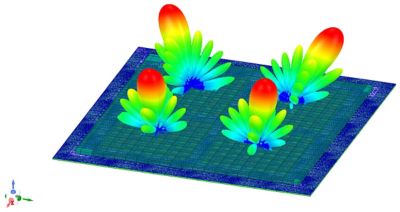-
United States -
United Kingdom -
India -
France -
Deutschland -
Italia -
日本 -
대한민국 -
中国 -
台灣
-
Ansys si impegna a fare in modo che gli studenti di oggi abbiano successo, fornendogli il software gratuito di simulazione ingegneristica.
-
Ansys si impegna a fare in modo che gli studenti di oggi abbiano successo, fornendogli il software gratuito di simulazione ingegneristica.
-
Ansys si impegna a fare in modo che gli studenti di oggi abbiano successo, fornendogli il software gratuito di simulazione ingegneristica.
-
Contattaci -
Opportunità di lavoro -
Studenti e Accademici -
Per Stati Uniti e Canada
+1 844.462.6797
ANSYS BLOG
March 30, 2023
How to Calculate and Increase Antenna Gain
Picture a perfectly spherical antenna. Radiating its energy equally in every direction, it evenly supplies the same electromagnetic intensity both vertically and horizontally. It’s called an isotropic radiator, and — spoiler — it does not exist. Unlike this idealistic and hypothetical model, every antenna in the real world has some directivity and emits more energy in a given direction. How this concentrated power is measured is called antenna gain.
What is Antenna Gain?
Antenna gain is the measure of an antenna’s ability to radiate a signal in any direction compared to the theoretical isotropic radiator. Antenna gain is typically given in decibels relative to isotropic (dBi). While it is closely related to directivity, it also considers the efficiency of the antenna.
Antenna Gain = Directivity + Efficiency
Because the isotropic radiator gives off the same energy radiation equally in all directions, it is said to have “no gain,” or 0 dBi. This value can only be achieved when none of the transmitted power is wasted, which is impossible for real antennas that are influenced by factors like electrical resistance. However, good design can make sure an antenna’s gain is aligned with the needs of its application.

Figure 1. A radiating 5G MIMO array.
Is High or Low Gain Better?
Gain seems like something you’d want more of, right? Surely a higher gain means a stronger signal and better connection — but not always. In some applications, you can actually have too much gain. It all depends on how the antenna is being used.
The best choice for hitting a receiver far away is definitely a high-gain antenna. Because the signal has to travel over a large distance, it needs to be intensified and pointed directly at the target.
But, if you need your signal to be received evenly by a broader area (for example, a wireless network in a sports bar), you don’t want a lot of gain. This is because gain is taking energy from one direction to boost it in another. If the application requires omnidirectional access, lower gain is better. Simply put: The higher the gain, the further the signal will go. The lower the gain, the broader the field pattern.
Other considerations for determining the ideal gain are location and signal source. High-gain antennas are ideal when positioned up high, or in flat areas without obstacles. And if you are unsure of where a signal is coming from (such as with mobile devices), a low-gain antenna may be preferable.
How to Calculate Antenna Gain
To measure the gain of an antenna, compare the power of the signal as it is transmitted to the power of the same signal as it would be transmitted by the isotropic radiator. The formula for calculating antenna gain is:
GdBi = 10log10(G)
How to Increase Antenna Gain
If your application will benefit from higher gain, there are several ways to increase it:
- Size: Larger antennas can capture more radio waves.
- Quantity: Multiple antennas can combine their signals (also known as antenna arraying).
- Surface: Reflective surfaces can redirect waves toward the antenna.
- Shape: Some antenna types, such as a Yagi antennas, are designed for higher gain.
Predicting Antenna Gain with Simulation
Simulation software, such as Ansys HFSS, shows engineers how changes in their design can affect antenna gain. Once identified, they can then adjust to increase or reduce gain, ensuring the antenna will meet the defined requirements before it’s built. Learn more about optimizing antenna design through simulation.










